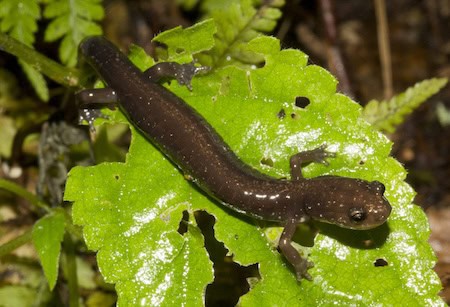The effects of a warming planet extend from the oceans to the mountaintops, harming people, plants, and animals. Climate change at Shenandoah National Park affects plants and animals, including the endangered Shenandoah salamander.
During a hike in the Virginia mountains, U.S. Senator Tim Kaine (D-Va.) learned about climate change at Shenandoah National Park. His insights and other science-based information illustrate the effects of a changing world.
In his 2024 book “Walk Ride Paddle,” Kaine shared insights from park superintendent Jennifer Flynn. “Warming temperatures affect the ability of species to reproduce and live,” Kaine wrote. “Some move to higher and higher elevations to stay cool. And when the temperatures warm enough even at the highest peaks, they simply disappear from the park.”
The National Park Service reported, “Due to large-scale deforestation and the use of fossil fuels (coal, oil, and natural gas) for transportation and electricity generation, humans are speeding up the rate at which the climate is changing.” Fewer trees and use of fossil fuels result in huge amounts of carbon dioxide released into the atmosphere, trapping solar radiation and warming global temperatures.
“Many of the changes we’re noticing are related to the phonology, or seasonal timing, of natural events, when plants bloom and go to seed, when animals migrate, the hatching of insects, and things like that,” said Matt Graves, Chief of Interpretation at Shenandoah National Park.
At the park, climate change impacts include:
- Warmer temperatures, increased rainfall, more extreme storms, more numerous wildfires, and more frequent insect outbreaks damage flora and fauna.
- Warmer stream waters stress native brook trout and other aquatic species.
- Milder winters and fewer frosts encourage invasive and pest species, which compete with native species, driving out native flora and fauna and creating a domino effect throughout the ecosystem.

One example is the endangered Shenandoah salamander (Plethodon shenandoah), an endemic species, found nowhere else on Earth. These small amphibians rely on the region’s cool, moist high mountain peaks. Its habitat is small and restricted – less than 1,500 acres, yet still part of a delicate ecosystem.
As the climate warms and dries, their continued survival is in doubt. Rising temperatures have already pushed them up the mountains. Red-backed salamanders seem to be outcompeting Shenandoah salamanders and encroaching on their habitat.
Since Kaine’s hike through Shenandoah National Park, the federal government has taken actions to combat climate change. The Great American Outdoors Act made investments in the national parks, including maintenance, infrastructure improvements, and resilience investments.
The Inflation Reduction Act, which makes investments in clean energy and renewables, is even more meaningful, Kaine said in a follow-up discussion of his book at the Library of Virginia. “The real way to deal with it is to just be a little bit cleaner tomorrow than we are today and just keep adjusting the dial toward low- and no-carbon energy incrementally – every day get better and better and better.”
Boomer takes a trip to Shenandoah National Park
More from Boom on climate change: Coral reefs and environmental resilience
Boomer editor Annie Tobey has been involved in publishing for more than three decades, editing magazines, creating hundreds of freelance articles for local and national publications, and publishing two books. Her first book, “For Any Young Mother Who Lives in a Shoe” (Judson Press, 1991), offered humor and guidance to parents of young children. More recently, “100 Things to Do in Richmond Before You Die” (Reedy Press, Sept. 1, 2023) gave Tobey the opportunity to share her love for her hometown of Richmond, Virginia.




